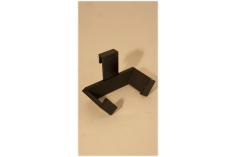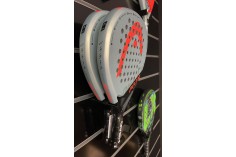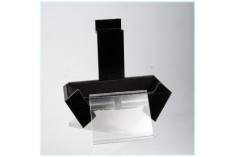The perfect padel racket wall: the visual strategy that boosts sales in shops and clubs
By Shelf2000.es · Commercial equipment for padel retail
The way you display padel rackets has become a key factor in selling more. Customers no longer accept a few random rackets hanging on the wall. They want to compare, understand the differences and feel they are buying from a specialist. This is where the racket wall comes in: a full wall, carefully planned, that turns the product into the real star.
1. The racket wall as a sales tool
A well-designed wall is not just decoration; it is a real sales tool. By concentrating the whole range of rackets on one surface, customers perceive variety, professionalism and expertise. Their eyes travel naturally along the line and every racket becomes a sales opportunity. In many European clubs and shops, this type of display has already become the standard.
Compared with improvised solutions or low-quality fixtures, a tidy wall inspires confidence and helps justify the price of the product. When the presentation is neat, customers assume there is a serious brand and a serious retailer behind it.
2. Order, height and visual reading
The first secret of the perfect racket wall is order. Grouping by brand, range or level of play makes the decision easier. Beginners quickly find their area, advanced players compare top-end models and undecided customers receive very clear visual guidance.
Height also matters. Rackets placed between 120 and 170 cm from the floor are the ones that sell most, because they are at eye and hand level. Below that range you can place entry-level or clearance models; above it, special editions or display pieces.
3. Professional brackets: small details, big results
For the wall to work, the brackets must be up to the job. Slatwall systems with ABS brackets allow precise alignment and regular spacing between rackets – something impossible with improvised hooks or DIY solutions. The feeling of order is reinforced racket by racket.
EVA-lined supports protect the frame and the grip, avoiding marks and scratches from daily use. These kinds of details make the difference between a wall that is simply “full” and a professional display ready to sell.
4. Lighting, floor and surroundings
The next level is lighting. A row of spotlights aimed at the wall highlights the rackets, creates volume and generates an effect similar to that of major sports stores. The contrast between a dark wall, well ordered brackets and a green or blue sports floor reinforces the feeling of a modern, technical space.
Placing the wall on the way to the courts or near reception guarantees a constant flow of eyes. Many customers had no plan to buy a racket, but start focusing on particular models simply because the display catches their attention every time they walk by.
5. How to apply this concept in your shop or club
Step 1: Choose the right wall
Ideally, it should be visible from the entrance or from the lounge area. Even if the space is limited, a short slatwall section can hold dozens of rackets with a clear reading.
Step 2: Define your ordering logic
Brand, level of play, player type or price range. The important thing is that customers understand the logic of the wall without having to ask. Small labels for each row help reinforce that structure.
Step 3: Install quality brackets
Use brackets specifically designed for padel rackets, made of ABS and adapted to slatwall panels. They let you maintain the same distance between models, correct heights quickly and update the wall every season without complex tools.
Step 4: Review the wall as if you were a customer
Take a few steps back and look at the whole surface. Ask yourself which models stand out, whether the organisation is clear and whether any area looks empty or overloaded. A couple of early adjustments can make a big difference in conversion.
A well-planned racket wall, with professional brackets and a carefully staged environment, turns every wall into a silent salesperson. It is not a passing trend; it is a modern, effective way of applying traditional common sense to padel retail.







